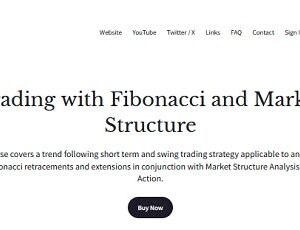Deconstructing Market Dynamics – The Volume Trader‘s Fibonacci Edge. This article delves into the intricacies of combining Fibonacci analysis with market structure and price action, explored through the lens of courses offered by platforms like Price Action Volume Trader. We’ll examine how a volume trader can leverage these techniques to identify high-probability trading setups, moving beyond the simplistic application of Fibonacci retracements and embracing a more holistic trading approach.
Volume trader
A volume trader is someone who pays close attention to trading volume to inform their decisions about when to buy or sell assets. They will use these figures as confirmation signals before entering into positions in order to find optimal conditions that they think will lead them toward profit. The approach recognizes that volume often precedes price movement: a surge in volume can indicate strong interest in an asset and might foreshadow significant price changes.
The Importance of Volume in Trading
Volume provides a level of insight that price action alone cannot offer. Price charts can reveal patterns and trends, but volume adds context. High volume during a price breakout, for example, suggests strong conviction behind the move, making it more likely to sustain itself. Conversely, a breakout on low volume might be a false signal, often referred to as a “fakeout.” This principle is a cornerstone of effective trading, allowing volume traders to differentiate between genuine opportunities and potential traps. Think of volume as the fuel in the engine of price; without enough fuel (volume), the car (price) won’t go very far.
Furthermore, analyzing volume trends can help identify accumulation and distribution phases. Accumulation occurs when large players are quietly buying up shares of an asset, often leading to a future price increase. Distribution is the opposite, where large players are selling their holdings, potentially preceding a decline. Recognizing these phases allows volume traders to position themselves accordingly, increasing their chances of capitalizing on these shifts. It’s about seeing the footprints of the “big money” and aligning yourself with their movements.
Disregarding volume is akin to driving with a blurred windshield. You might see the general direction, but you miss vital details that could lead to a crash. Volume traders use volume as a critical filter, improving their odds and reducing the risk of getting caught in adverse market fluctuations. Remember that not all price movements are created equal; volume helps you to determine the validity of each move.
Integrating Volume with Fibonacci
Combining volume analysis with Fibonacci tools creates a powerful synergistic effect. Fibonacci retracements and extensions provide potential areas of support, resistance, and price targets. However, these levels are more significant when they align with high volume nodes – price levels where a substantial number of shares or contracts have traded. A confluence of a Fibonacci level and a high volume node suggests strong buying or selling pressure, making it a potent area for potential trade entry or exit.
For instance, imagine a stock experiencing a pullback within an uptrend. A volume trader identifies a 61.8% Fibonacci retracement level. If this level also coincides with a high volume node from previous trading activity, it strengthens the case for a potential long entry. The high volume suggests that buyers are likely to step in at that level, providing support and potentially pushing the price back up.
Similarly, in a downtrend, a volume trader might look for short entry opportunities around Fibonacci extensions that align with high-volume areas. This confluence indicates a strong likelihood that sellers will defend those levels, further driving the price down. The key is to look for confirmation; Fibonacci levels offer potential, while volume provides validation of those potentials.
Therefore, effective volume traders don’t blindly trade every Fibonacci level. They wait for volume confirmation, looking for signs that the market is indeed respecting the Fibonacci levels. The integration also means recognizing when to avoid trades. If a break of a Fibonacci level occurs on low volume, it is more likely to be a fakeout, and a volume trader would abstain from entering a trade until better opportunities present themselves.
Volume Divergence and Fibonacci
Volume divergence is another powerful tool that volume traders use to confirm or negate trading signals around Fibonacci levels. Volume divergence occurs when price and volume are moving in opposite directions. For example, if the price is making a new high, but the volume is decreasing, it can signal that the upward trend is weakening, and a reversal might be imminent. Conversely, if the price is making a new low, but the volume is increasing, it can indicate that the downward trend is running out of steam, and a rally might be on the horizon.
Volume traders look for volume divergence when the price is approaching Fibonacci levels. If the price is approaching a Fibonacci resistance level with decreasing volume, it can suggest that the resistance is likely to hold, providing a high-probability short entry. Conversely, if the price is approaching a Fibonacci support level with increasing volume, it can suggest that the support is likely to hold, providing a good long entry opportunity.
The divergence adds an extra layer of confirmation, filtering out potential false signals and increasing the overall reliability of the Fibonacci-based trading strategy. It’s like having a second opinion from the market itself, helping volume traders make more informed decisions and manage risk more effectively. Using volume divergence in confluence with the Fibonacci levels makes it easier to spot high-quality setups.
Price action trading course
A price action trading course offers participants the tools to understand and interpret market movements through the analysis of price charts, candlesticks, and patterns. The goal is to provide traders with the capability to make decisions based on the raw price data, rather than relying strictly on lagging indicators. By mastering the techniques related to price action, traders can identify trends, reversals, and potential trading setups across all kinds of markets and timeframes.
Foundational Concepts of Price Action
The bedrock of any credible price action trading course lies in its education of fundamental concepts. These typically include candlestick patterns, support and resistance levels, trendlines, and chart patterns. A deep understanding of candlestick patterns, such as engulfing patterns, doji patterns, and hammer patterns, is crucial for identifying potential reversals or continuation signals. These patterns provide insights into the battle between buyers and sellers at specific price levels and can help traders anticipate the direction of future price movements.
Support and resistance levels represent price levels where buying or selling pressure is expected to be strong enough to halt or reverse price movements. Identifying these levels accurately is critical for determining potential entry and exit points for trades. A robust price action trading course will teach how support and resistance levels develop, how to identify them on a chart, and how to trade them effectively.
Trendlines are another important tool for price action traders. They help identify the direction of the prevailing trend and can also act as dynamic support and resistance levels. A well-drawn trendline connects successive higher lows in an uptrend or successive lower highs in a downtrend. Breaks of trendlines can signal potential trend reversals, providing traders with opportunities to capitalize on changes in market direction.
Chart patterns, such as head and shoulders, double tops and bottoms, triangles, and flags, offer insights into potential future price movements based on historical price behavior. Each pattern has specific characteristics and implications, and a comprehensive price action trading course will delve into the details and trading strategies associated with each one. Mastery of these foundational concepts is vital for any trader looking to make informed, data-driven trading decisions.
Advanced Price Action Techniques
Beyond the foundational concepts, effective price action trading courses also cover advanced techniques that can give traders an edge in the market. One such technique is the analysis of price action context, which involves understanding the broader market environment and how it influences price movements. Factors like economic news, geopolitical events, and market sentiment can all impact price action, and a skilled trader must be able to incorporate these factors into their analysis.
Another advanced technique is the use of multiple timeframe analysis. This involves analyzing price action on different timeframes to gain a more complete picture of market dynamics. For example, a trader might look at the daily chart to identify the overall trend, then zoom in on the hourly or 15-minute chart to find specific entry points. This multi-layered approach can help traders identify high-probability trading opportunities and manage risk more effectively.
Another key strategy is understanding order flow, because this is about seeing the market’s underlying buyers and sellers. By tracking the buying and selling pressures and spotting important data, traders can forecast future price activities.
Furthermore, learning about fakeouts and breakouts is crucial in complicated trading styles. These actions can trick traders into false opportunities and create losses. By learning to recognize these patterns and manage risk accordingly, traders can avoid common mistakes.
Effective price action trading course will also delve into risk management techniques, such as position sizing, stop-loss placement, and profit target selection. These techniques are essential for protecting capital and maximizing profits.
Combining Price Action with Fibonacci
The best price action trading courses recognize the power of combining price action with other analytical tools, such as Fibonacci retracements and extensions. Fibonacci levels can act as potential areas of support and resistance, providing high-probability entry and exit points for trades when they align with price action signals.
For example, a trader might identify a 61.8% Fibonacci retracement level that coincides with a key support level. If the price bounces off that level and forms a bullish candlestick pattern, it could signal a high-probability long entry. Similarly, a trader might look for short entry opportunities around Fibonacci extensions that align with resistance levels and bearish candlestick patterns.
The key is to use Fibonacci levels as confluence with price action signals. Instead of blindly trading every Fibonacci level, traders should wait for confirmation from price action to increase the odds of success. Doing so enables a more cautious and informed trading approach.
Price Action Volume Trader
Price Action Volume Trader can be considered a resource or brand offering education and tools focused on trading strategies that heavily rely on the analysis of price movements and volume data. It suggests an emphasis on understanding how price behaves in relation to volume in order to identify trading opportunities. The focus is on mastering trading techniques by combining price and volume insights.
The Philosophy Behind Price Action Volume Trading
The core belief of Price Action Volume Trader is that all the information needed to make profitable trading decisions is contained within the price and volume data itself. It rejects the notion that lagging indicators or complex algorithms are necessary for success. Instead, it advocates for a minimalist approach, focusing on understanding how price and volume interact to reveal the underlying dynamics of the market.
This philosophy is rooted in the understanding that price movements are driven by supply and demand. When demand exceeds supply, the price goes up. When supply exceeds demand, the price goes down. Volume provides insight into the strength of these forces. High volume indicates strong conviction behind a price move, while low volume suggests a lack of interest and a higher likelihood of a reversal.
Price Action Volume Trader encourages traders to become skilled observers of the market. It teaches them to read the language of price and volume, to identify patterns and signals that reveal the intentions of buyers and sellers. By mastering this skill, traders can anticipate market movements and position themselves accordingly. It’s like learning to decode a secret language that only those who pay attention can understand.
Furthermore, the Price Action Volume Trader focuses on developing trading strategies that are simple, effective, and adaptable to various market conditions. These strategies are based on the principles of price and volume analysis and are designed to be easily understood and implemented. The aim is to empower traders with the tools and knowledge they need to make confident, data-driven trading decisions.
Strategies and Techniques Used by Price Action Traders
Price Action Volume Traders employ a variety of strategies and techniques to identify trading opportunities. One common technique is volume spread analysis (VSA), which involves analyzing the relationship between price spread (the difference between the high and low of a candlestick) and volume. VSA can help identify areas of accumulation and distribution, as well as potential turning points in the market.
For example, a narrow spread on high volume can indicate that buyers and sellers are in equilibrium, suggesting a potential period of consolidation. A wide spread on high volume, on the other hand, can indicate strong conviction behind a price move, suggesting a potential breakout or breakdown. VSA provides a framework for understanding the interplay between price and volume and can help traders make more informed trading decisions.
Another technique is analyzing volume clusters, which are areas on a price chart where a substantial amount of volume has traded. Volume clusters often act as areas of support or resistance, as they represent price levels where many participants have a vested interest. Price Action Volume Traders look for opportunities to trade around volume clusters, anticipating that the price will react to these levels.
In addition to these specific techniques, Price Action Volume Traders also rely on traditional price action concepts, such as candlestick patterns, support and resistance levels, and trendlines. These concepts are used in conjunction with volume analysis to identify high-probability trading opportunities.
Advantages of Price Action Volume Trading
There are several advantages to using a Price Action Volume Trading approach. First, it is a relatively simple and straightforward method that does not require complex indicators or software. All that’s needed is a price chart and access to volume data, which is readily available on most trading platforms. This accessibility makes it an attractive option for both novice and experienced traders.
Second, Price Action Volume Trading is highly adaptable to various market conditions and timeframes. The principles of price and volume analysis apply equally well to stocks, forex, futures, and other financial instruments. It can be used on any timeframe, from intraday trading to long-term investing. This flexibility allows traders to tailor their strategies to their own unique trading styles and goals.
Third, Price Action Volume Trading can provide early signals of potential market movements. By analyzing price and volume data, traders can identify areas of accumulation and distribution, as well as potential turning points in the market. This early insight can give them a significant advantage over other traders who rely on lagging indicators.
Finally, Price Action Volume Trading is a skill that can be developed over time with practice and experience. The more time a trader spends analyzing price and volume data, the better they will become at reading the market and anticipating future price movements.
Trading With Fibonacci
Trading with Fibonacci, when done correctly, involves using Fibonacci retracements, extensions, and other tools to identify potential support and resistance levels, as well as potential entry and exit points for trades. However, the key is to understand that Fibonacci tools are not foolproof and should be used in conjunction with other forms of analysis, such as price action and market structure. The course description emphasizes using Fibonacci most effectively alongside these tools.
Understanding Fibonacci Ratios and Sequences
The foundation of trading with Fibonacci lies in understanding the Fibonacci sequence, which is a series of numbers where each number is the sum of the two preceding numbers (e.g., 0, 1, 1, 2, 3, 5, 8, 13, 21, and so on). The ratios derived from this sequence, such as 61.8%, 38.2%, and 23.6%, are believed to have significance in financial markets and are used to identify potential levels of support, resistance, and price targets.
Fibonacci retracements are used to identify potential areas of support during an uptrend or resistance during a downtrend. They are drawn by selecting two extreme points on a chart (usually a high and a low) and then dividing the vertical distance by the Fibonacci ratios. The resulting levels are then plotted as horizontal lines, representing potential areas where the price might stall or reverse.
Fibonacci extensions are used to identify potential price targets after a retracement has ended. They are drawn by selecting three points on a chart (usually a high, a low, and a retracement point) and then applying the Fibonacci ratios to project potential price levels beyond the high or low. These levels can be used to set profit targets or to identify potential areas where the price might reverse.
While Fibonacci ratios can be useful, they are not always accurate, and it is important to use them in conjunction with other forms of analysis. The extract clearly highlights that Fibonacci is not a standalone strategy and must be combined to provide the best result. This brings us to analyzing market structure.
Market Structure and Fibonacci Confluence
The Fibonacci course description from Price Action Volume Trader, underscores the importance of combining Fibonacci with market structure analysis. Market structure refers to the overall arrangement of price movements on a chart, including trends, ranges, support and resistance levels, and chart patterns. By analyzing market structure, traders can gain a better understanding of the underlying dynamics of the market and identify potential trading opportunities.
When trading with Fibonacci, it is essential to look for confluence — areas where Fibonacci levels align with key market structure elements. For example, if a 61.8% Fibonacci retracement level coincides with a key support level, it strengthens the case for a potential long entry. Similarly, if a Fibonacci extension level aligns with a key resistance level, it suggests a probability that the price reverses.
The course material indicates that market structure analysis includes identifying key structural elements like support and resistance, trendlines, breaks, and fakeouts and analyzing price behavior at these levels in conjunction with Fibonacci levels.
By combining Fibonacci with market structure, traders can increase the probability of success and reduce the risk of false signals. Remember that the more confluence you can find, the stronger the trading signal: a Fibonacci level, market structure support or resistance, and a price action reversal signal.
Advanced Fibonacci Techniques
Beyond the basic concepts of Fibonacci retracements and extensions, more advanced techniques can be used to refine trading strategies. One such technique is the use of Fibonacci time zones, which are used to project potential turning points in time.
Fibonacci time zones are drawn by selecting two points on a chart (usually a starting point and an ending point) and then dividing the horizontal distance by the Fibonacci ratios. The resulting vertical lines represent potential times when the price might experience a significant movement. However, like other Fibonacci tools, Fibonacci time zones should be used skeptically and in combination with other forms of analysis.
Another advanced technique is the use of Fibonacci clusters, which are areas on a price chart where multiple Fibonacci levels converge. Fibonacci clusters often act as strong areas of support or resistance, as they represent price levels where several Fibonacci ratios coincide.
Further, understanding Fibonacci ratios in conjunction with Elliot Wave Theory and Gartley Patterns, enables a deeper understanding of the underlying Fibonacci structure, making it easier for traders to anticipate potential movements.
Conclusion
The “Trading with Fibonacci and Market Structure” course, and resources like those offered by Price Action Volume Trader, present a comprehensive approach to trading that combines Fibonacci analysis with market structure and price action. By understanding the underlying dynamics of the market and using Fibonacci tools as confluence with other forms of analysis, traders can identify high-probability trading opportunities and manage risk effectively. The course’s emphasis on using Fibonacci as just one component within a larger analytical framework, is key to its potential effectiveness. This methodology offers a valuable framework for traders seeking to refine their strategies and improve their trading performance, particularly volume traders looking to incorporate Fibonacci into their existing toolkit. The price action trading course also highlights the importance of using Fibonacci for high quality setups and learning a discretionary trend-following strategy.
Sales page: _https://courses.priceactionvolumetrader.com/order?ct=754b8c0f-ad73-4c54-b5ad-c468a22f7154








